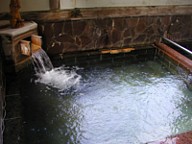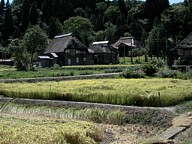- トップ >
- 普及・教育 >
- インターン生の受け入れ >
- 海外からの受け入れ ヤナさん滞在記
My first week in Japan: a warm welcome and a culture shock.
Flight SR 168 Zuerich-Tokyo. I had just fallen asleep when the crew switched on the lights and started to serve breakfast. Good-morning, it is 7:30 a.m., they said, for me it was 11:30 p.m.
Arrival
Narita Airport 8:50 a.m. The first problem arose: my luggage didn’t arrive, lost somewhere between Hamburg and Tokyo. So, I will go without cloths to work tomorrow? A few minutes later, I met the Japanese AIESEC students (the international students organisation which organised my internship in Japan). First difficulties in understanding each other’s English, in communicating. From the good English in the emails we had exchanged before, I didn’t expect such big problems with the communication in English. Then, we entered the train. I didn’t understand anything: no map of the entire train system was displayed, everything was written in Japanese letters. The ride: I saw the first rice fields in my life passing by the window. People around me fall asleep, in the middle of a public train! Then: changing trains again and again, changing tickets, endless paths and tunnels. At Shinjuku station we entered a restaurant to have lunch. My first trial to use chopsticks: a disaster!
From the window I watched the world around. Everything was so exciting and different: the big screens and colourful advertising tables on the walls, the girls in fashionable cloths, short skirts and high heels, police men with whistles guiding the traffic.
My host family
Arrival at my host families house. The whole family was waiting at the entrance (genkan), bowing and smiling at me. A huge part of the house looked as described in the books I read about Japan: doors and windows made of wood and paper, tatami rooms, futons to sleep on. But other rooms were furnished in western style.
The JAES21
(「環境文明21」オフィスにて)
The next morning (after spending a night without sleep on a hard futon) I got up early to start my first day in the JAES21. I was excited: How will it be to work in a Japanese NGO? The first surprise at the entrance: even in an office you change your shoes against sleepers. Apart from that the office looked like a German office as well. I was warmly welcomed, everybody answered my questions and helped me. I got a first inside into the activities of the JAES21, the structure and aims. The next days I got to know my colleagues better and experienced the daily life in the office. Some tasks were assigned to me like writing a report about education on sustainability in Germany. Thanks to Tomoko Tezuka, who speaks excellent German, all important things were translated to me. Nevertheless, I felt that the lack of my ability to speak Japanese is a pity, otherwise I would understand much more. The welcome party started with a Japanese-European dinner (Pizza and Sushi) followed by talks about various subjects e.g. about Japanese and German differences, especially in the field of Environment. After this first week full of new impressions, I am starting now into one week of summer holidays and I am looking forward to my remaining 6 weeks with the JAES21.
6 weeks in Japan: Typhoon, Hanabi and Onsen
After six weeks in Japan, many things have changed for me. The first problems with the foreign culture have been overcome and new impressions broadened my view of Japan. I have familiarized with Japanese habits and the people surrounding me. Thanks to many invitations, I have been able to experience many different aspects of Japanese life.
Second week: Tokyo
Already the second week was off. I joined an AIESEC group for a tour to Tokyo. The program was very well elaborated, one could see that intensive planning had been done before. But cultural differences between the participating trainees from abroad and the organising Japanese led to some problems. Japanese group mentality and care for eating clashed with western individuality and the wishes of some participants to spend most of the time with seeing shrines, temples and other traditional sites.
Third week: Typhoon
This week contained the experience of an entirely new phenomenon for me: the typhoon. But being not very strong in our region, the typhoon was much less frightening than I had expected. Instead of flying bikes and road signs, I had to cope with flood-like water streams on my way home. It reminded my of thunder-storms in Germany when parts of my hometown are under water and cars are starting to swim.
Fourth week: Hakone
The weekend of the fourth week, I went to Hakone. I was once again overwhelmed by the beauty of this country and the Japanese sense for natural elegance when building their traditional temples, shrines, torii, parks and paths. Moreover, I was surprised to find my guest house caring very much for environmental issues and thus trying to save energy, waste and reuse and share as much as possible.
Fifth week: Niigata
The fifth weekend I had the opportunity to join my colleague on her trip home to Ojiya. What a wonderful time: relaxing in a natural outside onsen, seeing the rice fields in the harvest time and after all enjoying the biggest hanabi in the world from the first row!
 |
 |
 |
| 日本の秘湯を体験! Photo by Janna Schoenfeld |
稲刈りシーズンの農村を訪ねて Photo by Janna Schoenfeld |
花火も楽しみました Photo by Janna Schoenfeld |
Sixth week: General Assembly of JAES21
In the six week, everybody was busy with preparations for the big event on Saturday. Finally, everything worked out very well. I had the role of the official photographer and got to know some of the members of JAES 21.
| 全国交流大会では、フォトグラファーとして活躍 Photo by Janna Schoenfeld |
大会終了後の懇親会にて |
環境文明21での8週間の研修を終えて
ドイツの”エコ”と日本の”エコ”私から見た環境分野でのドイツと日本の違い
ドイツで“エコ”な人といえば、伸ばし放題のくしゃくしゃにもつれた長髪に、黄麻(ジュート)の袋をさげてサンダルで歩いている、ちょっと薄汚れた若者を想像する。日本で“エコ”な人は、私が見る限りでは、書類かばんとラップトップを手に、背広に身を包んだきちんとした身なりの中高年の人々、そして彼らは良く名の知られた大企業で働いている人のようだ。ドイツでは、地域の市民団体が環境運動の基盤を担っているが、日本では環境保護を促進しているのは経済界のエリート達。この違いは、どうやら両国のもつ環境意識のルーツが異なることに関係しているようだ。
ドイツの環境保護運動は1960年代後半から70年代初頭に発生した社会運動と強く結びついている。これは反権威・体制、社会主義、反原発、そしてより直接的な民主主義などをめぐる運動であった。ドイツでは下からの運動が重要であるが、日本では変革を説いて歩くのは物分かりの良いエリートのようだ。この異なるバックグラウンドは、両国の環境に配慮した行動にたくさんの相違を生み出している。ドイツにおける環境運動への広い社会的支持は、日常の多くの場面で環境を意識した行動を定着させた。
特にその違いが目に付くのは、買い物の時だ。たくさんのコンビニエンスストアや自動販売機が日本では24時間いつでも利用できる。ドイツでは自動販売機はほとんどなく、お店は18時から20時の間に閉じる。日本のスーパーマーケットの商品は二重三重に包装され、しかもそれらはたいていプラスチックだ。日本のスーパーで買い物をする人は、プラスチック袋や使い捨てのフォーク、割り箸の山ができるのを阻止できないだろう。ドイツの格安スーパー「アルディ」でも、買い物客はプラスティック袋が必要なときにはお金を払わなければならない。その袋は日本のものより大きくしっかりしていて、完全に生物分解可能な素材で出来ている。そして袋には目立つ字でこう書いてある。「この袋は繰り返し使ってください!」。
日本では、お祭りのときに来場者がごみを持ち帰るよう促すために、ごみ箱を設置しないことが議論されているそうだが(ドイツのことわざにも“目に入らないものは忘れ去られる”とある)、ドイツでは、法律により生産者や小売店が、取り扱った包装材を引取り、規定の再使用率を満たさなければならない。この法律の施行によって、いかにすばやく生産者たちが包装材の削減に取り組んだか、日本の方々に想像がつくだろうか。
動物保護はどうだろう。ドイツの動物保護活動は、動物たちも喜びや悲しみといった感情や、欲求を持っているということを、世論に訴えかけることに成功した。犬や鳥、リスたちが、藁も敷かれていない狭いかごに入れられ、店頭で売られているなんて、ドイツのペットショップではとても考えられない。時折、ドイツの過激な動物愛護者たちが、ひどい環境で暮らすショップの動物たちを自由にしようと、夜の間にこっそり逃がしてしまうことがある。ただ、ショップの経営者たちが動物たちのケアに気を配るのは、動物たちが逃がされていないか心配するためだけではない。お客自身やドイツの動物保護法が、ペットショップの経営者たちに動物たちの種に応じたケアを命じているのだ。
しかし、当然ながら、逆に日本の方がドイツより環境の分野で進んでいる例もある。特に公共交通機関の整備は進んでいる。少なくとも首都圏では、近郊公共交通機関が網羅されていて、安全で清潔で速い。ドイツでは薄汚れた危険な雰囲気の漂う地下鉄に、誰も乗りたいと思わないだろう。
以上のようないくつかの例えから言えることは、お互いから多くのことを学び合えるということだ。持続可能な未来を実現することは、同時に、ほかの文化を理解するということ、そして交流し良いアイディアを自分自身の文化に取り込んでいくということだ。こうした観点から、環境文明21での研修は、私にとって大変成功に満ちたものであった。環境文明21のみなさん、心から、どうもありがとう。